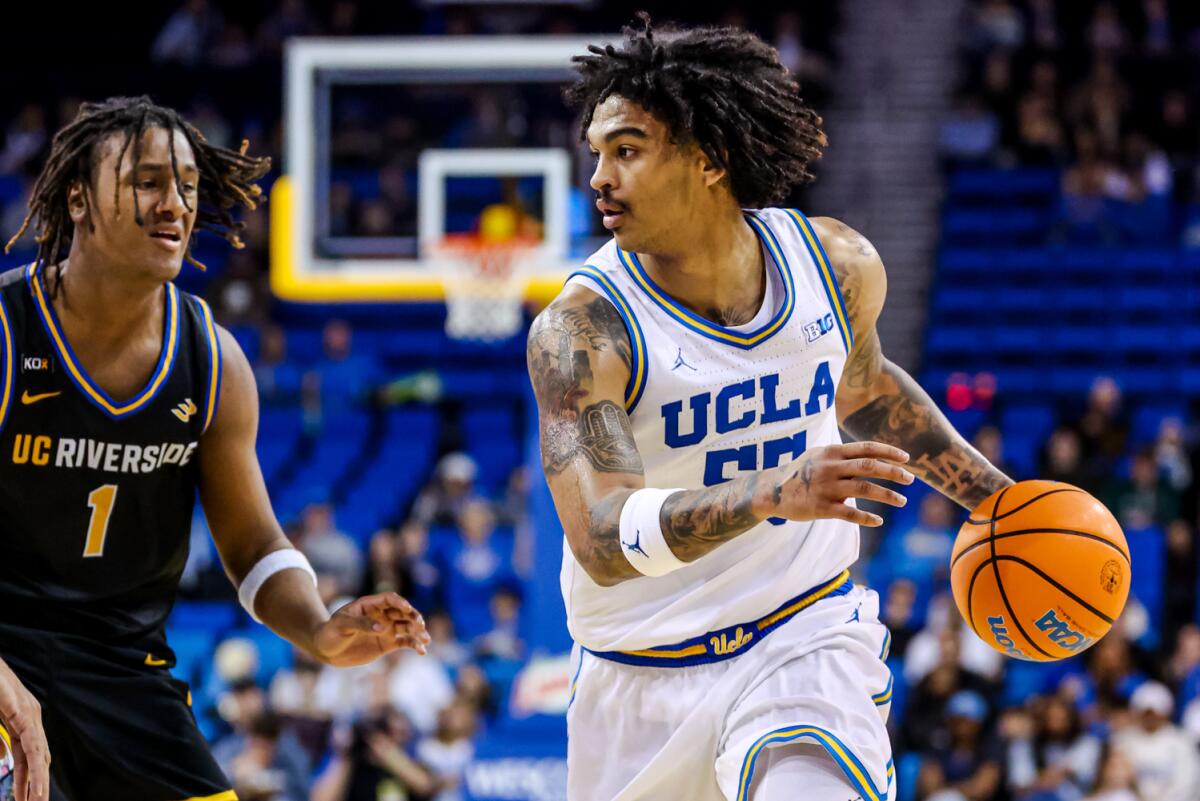Mick Cronin tinkers with lineup during UCLA’s rout of UC Riverside
Facing an overmatched opponent that allowed him to freely tinker with his lineups, UCLA coach Mick Cronin tried plenty of mixing and matching Tuesday afternoon.
Perhaps the biggest takeaway was that a three-guard lineup might be the way to go after the continued struggles of centers Xavier Booker and Steven Jamerson II.
“We’ve got to find a way to play our best players and win, whoever they are, because it’s not Little League,” Cronin said after his team’s 97-65 victory over UC Riverside at Pauley Pavilion. “You’ve either got to give us some rebounding and defense or somebody else has got to play.”
The leading candidates for a larger role based on what happened against the Highlanders appear to be reserves Trent Perry, Jamar Brown and Brandon Williams.
Perry was a playmaking force with his scoring and smart passes. Brown did a little bit of everything in an energetic fashion. Williams showed plenty of toughness as the second big man in small lineups also featuring Tyler Bilodeau, who was an offensive juggernaut against a team that provided little defensive resistance.
“The biggest thing I care about is winning,” said Bilodeau, who finished with a career-high 34 points while making 12 of 19 shots to go with six rebounds. “So whatever we need to do to get that done.”
Cronin joked afterward that Bilodeau shouldn’t have missed any shots because he needlessly took fadeaway jumpers.
“They don’t double [team],” Cronin said of the Highlanders, “so I said, ‘Buddy, you’ve got one night here where they’re just going to let you keep dribbling until you shoot, so go have fun. Keep going at the rim until you score.’ ”
Guard Skyy Clark added 14 points to help UCLA (10-3) post its third consecutive victory going into an extended winter break. Forward Osiris Grady finished with 20 points for the Highlanders (6-8), who shot 42.6% to the Bruins’ 50%.
The game’s biggest revelations came off the UCLA bench. Perry might have been the biggest, running the offense at a high level while finishing with 14 points, seven assists and zero turnovers in 24 minutes. Cronin went with some lineups in the second half featuring Perry alongside starting point guard Donovan Dent (seven points and three assists in 19 minutes).
“Three-guard lineup, we’ve been pushing in transition a lot more,” Perry said. “I mean, we’re just finding the groove before Big Ten” play.
Brown contributed across the board, tallying four points, seven rebounds and four steals in 24 minutes.

UCLA guard Skyy Clark drives against UC Riverside guard De’Undrae Perteete Jr. during the Bruins’ win on Tuesday.
(Jan Lim / UCLA Athletics)
“A tremendous portal find,” Cronin said of the transfer from the University of Missouri-Kansas City. “Great toughness. He’s a winning player.”
Williams’ biggest factor was his defense during a performance in which he had three points, one rebound and one steal in 18 minutes. The big question was whether he was providing more than the player whose spot he took.
Booker finished with six points and one rebound in 13 minutes, unfurling a second consecutive subpar showing after being limited to three minutes against Cal Poly because of matchups. Jamerson played only seven choppy minutes, once being yanked after an 11-second stint because of an inability to keep the Highlanders from reaching the rim with ease.
“Got to get better,” Cronin said of his centers. “I just talked to them about that.”
UC Riverside repeatedly made the mistake of leaving Bilodeau open in the first half and the forward made the Highlanders regret their decision by making five of nine shots on the way to 13 points. After having been UCLA’s primary center last year, Bilodeau said he was happy to go back to that role if that’s what his coach needed.
“Tyler would probably tell you he gets more open shots when he’s playing the five,” Cronin said, “because the other team’s five man is guarding him.”
Cronin said the issue that arises when going small is the need to be an elite offensive team — territory the Bruins might be approaching. Their offensive efficiency is ranked No. 27 nationally by the metrics of basketball analyst Ken Pomeroy, their best since they were No. 21 during the 2022-23 season that ended in the Sweet 16 of the NCAA tournament after season-ending injuries to Jaylen Clark and Adem Bona.
If this is the best version of the Bruins, Cronin appeared ready to roll with it.
“All that matters is who you become, not in the last game or the game previous to that, so we’re on a search,” Cronin said. “Just like every team, it’s not who you are now, it’s who you are at the end and can you get enough wins along the way?”
